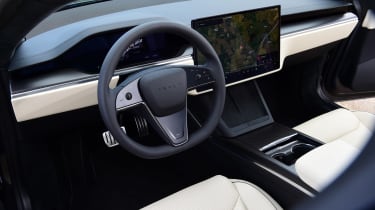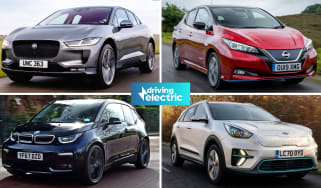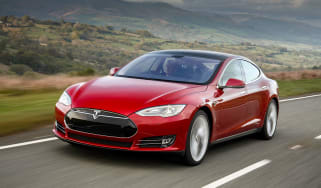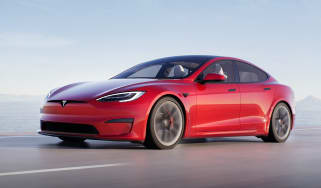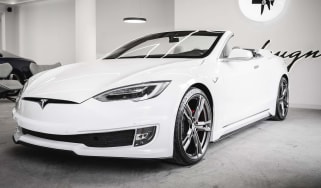Tesla Model S review
The Tesla Model S set the bar that all other long-range EVs had to meet – but you can no longer buy a right-hand-drive car in the UK
Pros
- Long range
- Supremely quick
- Futuristic technology
Cons
- Very expensive
- Now left-hand drive only
- Not as fun as a Porsche
|
Model |
Range |
Wallbox charge time |
Rapid charge time |
|
Long Range |
394 miles |
15hrs 15mins (0-100%, 7.4kW) |
30mins (10-80%, 250kW) |
|
Plaid |
373 miles |
15hrs 15mins (0-100%, 7.4kW) |
30mins (10-80%, 250kW) |
Tesla Model S verdict
The Tesla Model S was one of the first truly ‘premium’ electric cars and thanks to constant updates, we think it's still a compelling package more than a decade later. It’s fast, good to drive, and boasts one of the longest ranges of any electric car on sale – not to mention the boon that is complete access to the industry-leading Tesla Supercharger network. Yes, it’s more expensive than it’s ever been and is now left-hand drive only, but improvements in performance, technology and – most crucially – interior quality, mean it can still mix it with the very best.
Range details, specs and alternatives
When the Tesla Model S launched in 2012 (or 2014 by the time it arrived here in the UK) there were no other premium electric cars around. In fact, the only other mainstream electric cars on sale were the first generation Nissan Leaf and Renault ZOE. But since then, not only has Tesla introduced three new cars – the Model X seven-seat SUV, Model 3 saloon and Model Y family SUV – a few brands have launched their response to the game-changing Model S.
The Porsche Taycan and Audi e-tron GT sports saloons are both fantastic to drive, meanwhile the Mercedes EQS and BMW i7 are true luxury electric flagships. The Model S’ new arch-rival, the Lucid Air, has also been showing it up when it comes to driving dynamics, range and charging speeds – though we’re still waiting for the disruptive US maker to launch in Europe.
Over the past decade, more than a dozen versions of the Tesla Model S have been available, we’ve seen 60, 60D, 70, 70D, 75, 75D, 85, 85D, P85+, P85D, 90, 90D, P90, 100D and P100D versions. The numbers signified the capacity of the car’s battery pack in kWh (kilowatt-hours), with a larger number signifying more power and greater range. The P signified a particular performance-oriented powertrain, while the additional D stands for dual-motor, with those variants getting four-wheel drive.
In 2021, the Model S was overhauled with new styling, cabin design and motors to choose from. One of the most controversial elements of the Model S’ facelift was the addition of a steering yoke (pictured above), but since then Tesla has backtracked and now gives customers a choice of a regular steering wheel when ordering.
The updated Model S Long Range uses a roughly 100kWh battery pack to power two electric motors, with the combination offering up to 394 miles of range and 0-60mph in just over three seconds.
Above that sits the new Model S Plaid; it pairs the same battery pack with a tri-motor setup – two motors on the rear axle, one on the front – produces more than 1,000bhp, will do 0-60mph in under two seconds and can cover up to 373 miles on a charge, according to Tesla. It needs to be driven to be believed – something we’ve now done in the UK; read on for our first impressions.
Both the standard car and flagship Plaid are now available to buy from stock (around 20 cars were available on the maker’s site at the time of writing) though in May 2023 Tesla announced it would not be building any right-hand drive Model S (or Tesla Model X) variants for the foreseeable future.
We don’t think this needs to be the dealbreaker it might first appear, but Tesla has offered existing deposit holders three years’ of free Supercharging as way of an apology, or a £2,000 incentive to switch their order to the smaller Model 3 or Model Y.
Click here to see why you can trust DrivingElectric reviews, or for a more detailed look at the Tesla Model S, read on for the rest of our in-depth review...

